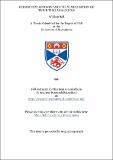Files in this item
Ferrocenylketones and the stabilisation of their thio analogues
Item metadata
| dc.contributor.advisor | Glidewell, Christopher | |
| dc.contributor.author | Bell, William | |
| dc.coverage.spatial | 248 p. | en_US |
| dc.date.accessioned | 2018-07-05T09:37:23Z | |
| dc.date.available | 2018-07-05T09:37:23Z | |
| dc.date.issued | 1991 | |
| dc.identifier.uri | https://hdl.handle.net/10023/14964 | |
| dc.description.abstract | An effective method for the stabilization of otherwise unstable thiones is their complexation to M(CO)₅ (M= Cr, Mo, W). This complexation led to a very stable material of composition C₂₂H₁₄CrFeO₅S, whose crystals are triclinic, space group PI (No. 2) with a=9.058(7), b=10.040(7), c=12.568(8) Å, α=113.70(5), β=93.42(6), γ=95.25(6)° and Z=2. The structure was refined from diffractometer data to an R value of 0.0049. The structure was found to be that of pentacarbonyl(thiobenzoylferrocene-S) chromium, in which the Cr(CO)₅ fragment is bonded to the sulphur atom of the thioacyl ferrocene. The photodegradation product was found to have a composition of C₁₇H₁₄FeO, crystals were monoclinic, space group P21 (No. 14) with a=6.09(6), b=15.145(7), c=14.263(4)Å, β=105.91(1)° and Z=4. The structure was refined to an R value of 0.059, and was found to be benzoylferrocene. 1,1'-Dibenzoylferrocene reacts with tetraphosphorus decasulphide to yield, in addition to the expected 1,1'-bis(thiobenzoyl)ferrocene, a minor, yellow by-product of composition C₂₄H₁₈FeS₃, whose crystals are monoclinic, space group P2₁/n with a=11.769(3), b=11.750(4), c=14.835(2) Å, β=98.63(1)°, and Z=4: the structure was found to be that of 1,4-diphenyl-1,4-epithio-2,3-dithia[4](1,1')-ferrocenophane in which the two rings of the ferrocene nucleus are spanned by a 1,2,4-trithiolane ring. Whereas the reaction of ferrocene with a stoichiometric quantity of Me₃CCOCl/AICI₃ provides the monoacylated product in 87% yield, the use of excess of the acylation reagent leads to simultaneous acylation and alkylation, two products of which have been isolated and characterised by 1H and 13C NMR, spectroscopy as 1,1/3-tri-t- butyl-3'-(2,2-dimethylpropionyl) ferrocene, [C₅H₃(CMe₃)₂] Fe [C₅H₃(CMe₃)COCMe₃)] and 1,1'-di-t-butyl-3,3'-bis(2,2-dimethylpropiony)ferrocene, [C₅H₃(CMe₃)(COCMe₃)]₂Fe . Flash Vacuum Pyrolysis of a number of ferrocenes have been carried out and the mono and diacyl ferrocenes were found to display a high degree of thermal stability, most of these being recovered in almost quantitative yields at furnace temperatures up to 700 °C. Ferrocenecarboxaldoxime acetate was found to yield cyanoferrocene and acetic acid in a clean reaction in which the cyanoferrocene was uncontaminated with the acetic acid. Crystals of the low melting form of ferrocenecarboxaldoxime, (C₅H₅)Fe(C₅H₄CH = NOH) are monoclinic, space-group C2/c with a= 26.512(6), b = 12.798 (4), c = 12.855 (2)Å, β = 114.37 (1)°, and Z = 16. The structure was refined from diffractometer data to an R value of 0.054. There are two molecular sites in the asymmetric unit, and both sites contain a disordered mixture of E and Z geometrical isomers. There are no close contacts between the iron atom and the hydroxyl group of the oxime substituent, but rather there is extensive intermolecular hydrogen bonding. | en_US |
| dc.language.iso | en | en_US |
| dc.publisher | University of St Andrews | |
| dc.subject.lcc | QD305.K2B3 | |
| dc.subject.lcsh | Ketones | en |
| dc.title | Ferrocenylketones and the stabilisation of their thio analogues | en_US |
| dc.type | Thesis | en_US |
| dc.type.qualificationlevel | Doctoral | en_US |
| dc.type.qualificationname | PhD Doctor of Philosophy | en_US |
| dc.publisher.institution | The University of St Andrews | en_US |
This item appears in the following Collection(s)
Items in the St Andrews Research Repository are protected by copyright, with all rights reserved, unless otherwise indicated.

